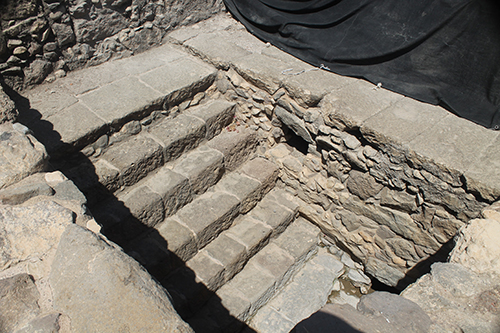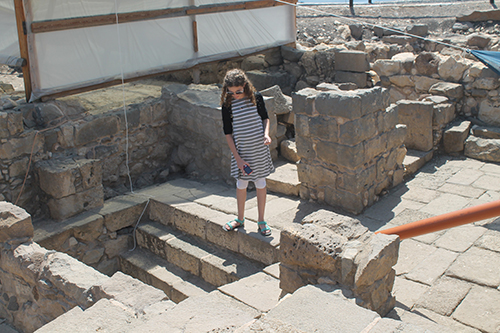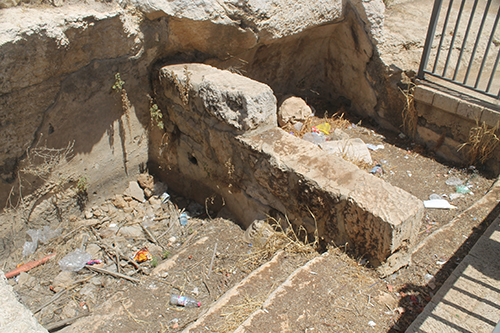

by Luke Chandler
Synopsis: Where did the apostles baptize 3,000 people in Acts 2? Archaeology illuminates this answer, and illustrates our salvation today.
The apostles immersed 3,000 believers on Pentecost Day in Acts 2, but where exactly could they do it? Jerusalem was not by a river or lake but sits in the Judean mountains, miles from any significant body of water. The city's original water source, an underground spring, fed the Pool of Siloam, but it takes a long time to immerse 3,000 people in a single public pool, especially with holiday crowds.
The apostles probably used the numerous mikvehs around the Temple Mount. A mikveh was a stepped immersion pool used by Jews for purification. Before prayer or worship, a Jew would immerse himself in the water of a mikveh to become ritually clean. Archaeologists have discovered hundreds of mikvehs in excavated Jewish communities from before, during, and after the time of Jesus. One mikveh was recently identified by a medieval Jewish structure as far away as Marseille, France.
Mikvehs arose from the continual emphasis on washing in the Bible. God created the world, pure and good, through water (Gen. 1:2, 6-7). The flood cleansed the world of sin in Noah's time (Gen. 7-8, 1 Pet. 3:20). Israel entered the Covenant through a "baptism" in the cloud and the Red Sea (1 Cor. 10:1-2) and entered Canaan through the waters of the Jordan. Priests under the Mosaic Law frequently washed before engaging in worship at the tabernacle or temple (Exod. 29:1-4, 30:20, et al.). It is no surprise Jesus chose to be immersed in water before beginning His ministry as our High Priest (Matt. 3:13).
Mikvehs arose during the intertestamental period and were widespread by Jesus' time. They have been found in nearly every place where Jews lived. The pools were typically located near synagogues, as we can see today in the ancient ruins of Magdala and Chorazin. Unique religious communities, such as Qumran, had multiple pools to satisfy the high demand for ritual purity. Jews in Jesus' time had extended this concept to other aspects of life such as meals, regularly washing their hands, the dinnerware, and even the furniture (Mark 7:3-4)!
Archaeologists have discovered more than 125 mikvehs near the temple mount, many of them along a main road that led to the southern entrance. Jews, both men and women, would sing Psalms of Ascent as they walked up to the temple. They would purify themselves for worship by immersing in one of the mikvehs near the main entrance. Jesus, as a Jew, would have used these same mikvehs before entering the temple area. Paul certainly would have used them, especially on his last visit in Acts 21:26 when "he purified himself… and went into the temple."
Many Jews were immersed in mikvehs hundreds of times or more during their lives. When Peter told listeners to be immersed "in the name of Jesus Christ for the forgiveness of your sins" (Acts 2:38), everyone understood what he meant and knew where it could be done. This occasion, however, did not involve a ritual, repeatable immersion. This was a baptism in the name of Jesus, washing away sin once, for all time. In that moment, the mikveh, like the temple and its sacrifices, became obsolete.
Our baptism evokes the ancient mikveh rituals. Most church buildings today include their own small, stepped pool for immersion into Jesus Christ. The next time we look on one of these modern baptismal pools, we may recall its connection to the mikvehs of Jesus' time, and even to the pure world that was formed through water in the sinless beginning of creation.
Author Bio: Luke Chandler has preached the Gospel for more than twenty years and currently works with the North Terrace congregation in the Tampa area. He has led tours and excavated in Israel for nine years. Luke and his wife Melanie have five children. He can be reached at lukechandler@verizon.net.

Image 1: This photo shows a recently discovered mikveh from the Galilean town of Magdala, and it dates to Jesus' time. It is possible Jesus used this before probably teaching in the nearby synagogue.

Image 2: This photo shows my daughter standing beside a mikveh in Magdala.

Image 3: This photo has a pair of mikvehs along the pilgrim road to the temple mount. People going up to worship (such as 12-year-old Jesus with his parents?) could stop here or at other ones along the way to immerse and become "clean" before entering the temple. Locals obviously use it for something else today.
